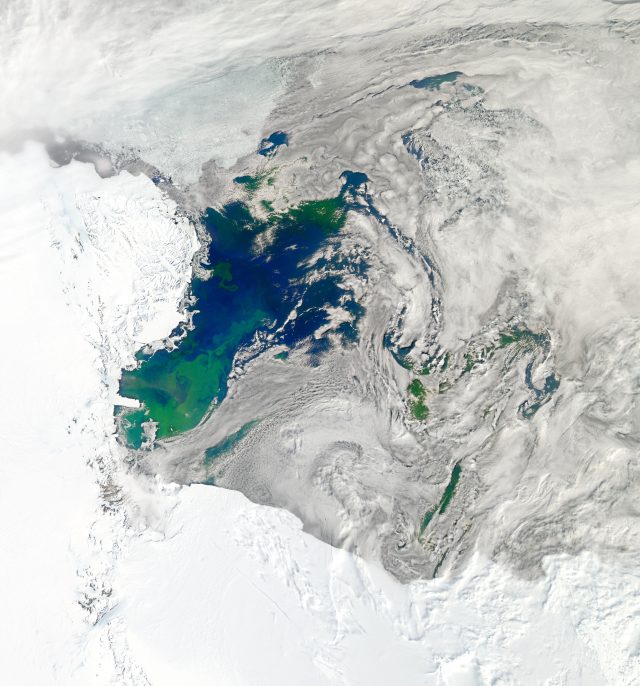
To understand what climate change will bring in the future, we often look to the past. Sometimes the past helps us study the workings of the climate system in general, but sometimes we look to it to find analogous periods of rising greenhouse gases and temperatures.
The last time the concentration of carbon dioxide in the atmosphere was as high as it is today was several million years ago in the Pliocene. Atmospheric CO2 was between 350 and 450 parts per million then (it’s nearly 400 today), and the global average temperature was roughly 2-3°C warmer than today. (Even if we capped CO2 where it is today, at 400 parts per million, the planet would continue to warm and would probably eventually reach similar temperatures.)
The Pilocene's warmth, as expected, altered the sea levels. Sea level is notoriously difficult to pin down once you go that far back, but it appears to have been somewhere between 12 and 32 meters higher than it is today. Even completely melting Greenland and West Antarctica would only yield about 12 meters, so it seemed clear that the much larger East Antarctic Ice Sheet must have contributed.
A good portion of the land beneath the West Antarctic Ice Sheet sits below sea level, and much of that ice sheet reaches the sea, where it forms ice shelves. This makes it very sensitive to temperature changes. The East Antarctic Ice Sheet, however, is thought to be considerably more stable. The land beneath it sits at higher elevation, and ice shelves are much less important. That leads to a lot of uncertainty about how much it could have melted during the Pliocene and what it might do in the future.
This requires reconstructing the history of an ice sheet. There are great ways to study glaciers that recently retreated (melted to a smaller size) and some good ways to study glaciers that retreated long ago. It’s much trickier to study the history of a glacier that has advanced over the evidence of its history, but one way to find clues is to examine the sediment that flows out from the end of the glacier.
Imagine someone is taking a belt sander to a piece of wood with three broad stripes of color. (Maybe it’s a wooden replica of some Neapolitan ice cream.) You arrive afterward to clean up the mess and find all three colors represented in the sanding dust. When you next return, however, there are only two colors of dust—there’s no strawberry to be seen. You could use that to infer which parts of the wood were being sanded each time.
When multiple distinct groups of rocks are present below a glacier, the same information can be inferred. If the glacier retreats back far enough, it may stop eroding some rocks and the sediment deposited at the end might be missing the strawberry.
Researchers working with the Integrated Ocean Drilling Program collected a core of sediment offshore from the Adélie Land region of the Antarctic Coast. The sediment in the core alternated between layers containing lots of diatom plankton (representing warmer times with less sea ice) and layers with few. The presence of sediment from different groups of rocks was determined from isotopes of strontium and neodymium. In the warm, diatom-rich layers, the isotopes shifted relative to the diatom-poor layers.
So how far back does that mean this portion of the ice sheet must have retreated during those warmer intervals? It seems that it must have pulled back hundreds of kilometers from the rocks along the coast. There’s a basin with igneous bedrock beyond that, and it appears the ice was still present and grinding away there. Warmer ocean water could have caused the ice shelves in this area to collapse, destabilizing the coastal portion of the ice and driving it back into the basin.
Ice sheet model simulations in which the ice in this area retreats that far inland give a total Pliocene sea level contribution of 3 to 10 meters from the East Antarctic Ice Sheet.
In conversations about climate change in the future, the eastern portion of the Antarctic Ice Sheet is often left out, being thought of as too stable to be a player. But under temperatures brought about by greenhouse gas concentrations similar to today’s, at least parts of the East Antarctic Ice Sheet were melting back and raising sea level.
Your third grade classmates all had different breaking points. One poke in the back and some would haul off and slug you. Others had to be prodded for much longer before responding with force. Greenland and the West Antarctic Ice Sheet may have shorter tempers, but a couple degrees Celsius looks to be enough to make parts of the East Antarctic Ice Sheet lose their cool, too.
Nature Geoscience, 2013. DOI: 10.1038/NGEO1889 (About DOIs).
reader comments
49